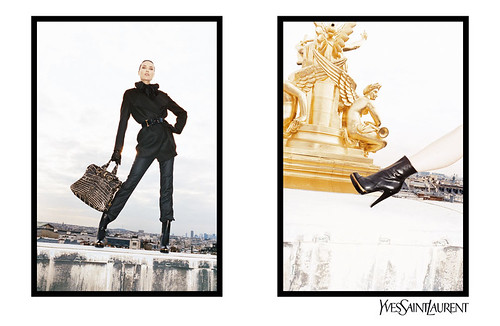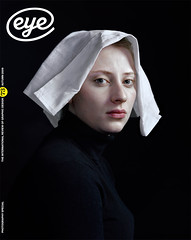Autumn 2009
Art and art direction – Thomas Lenthal
Thomas Lenthal, creative director for luxury fashion brands and his own magazine Paradis.

French luxury brands are not for the faint of heart. Their ad campaigns can test the sensibility of those who are not aroused by the sight of action-figure goddesses in torn fishnet stockings. In the past decade, as the result of an unholy alliance between the couture world and the contemporary art scene (thanks in no small part to Bernard Arnault, billionaire collector and chairman of the fashion conglomerate LVMH), trollop chic and hardcore glamour have become the mainstay of many upscale fashion magazines. Luxury, once synonymous with opulence, has become a guerrilla attack on sanitised bourgeois values.
It was French creative director Thomas Lenthal who set the standards with a 2001 campaign for Dior that was nothing short of a porn-hip manifesto.
An alumnus of French Glamour, a founding partner of slick fashion magazine Numéro and a seasoned freelance advertising art director with clients such as Cacharel, Tod’s and Kenzo, Lenthal was hired by Dior designer John Galliano to ‘wake up sleeping beauty’. He directed British photographer Nick Knight to stage a series of tableaux that looked at first glance like police pictures of injured car crash survivors, their bruised bodies covered with diesel, their clothes a mess, dazed expressions on their faces. The models, swathed in skimpy yet extravagant togs, sported strappy high-heeled sandals and clutched pristine Dior handbags.
The campaign put Dior on the map. ‘It was meant to be outrageous,’ says Lenthal. ‘The client said, “Please, do burn down the house,” so we did.’ However, what seemed to most an unnecessarily obscene proclamation on the part of a hitherto boudoir-ish brand was in fact a superlative exercise in cultural referencing.
A recent YSL campaign by Juergen Teller: fearless fashionista parading atop the Paris Opéra Garnier.
Top: art direction by Thomas Lenthal. Image from Dior campaign by Nick Knight, Inez van Lamsweerde and Vinoodh Matadin, 2008, portraying a cool vamp.
According to Lenthal, ‘art directors and photographers communicate with each other by sharing obscure visual references.’ The history of photography, illustration and film is a common language between them.
‘For instance,’ he explains, ‘we’d elaborate with a photographer what we had in mind for the next shoot as a cross between German lesbian erotic photographs of the 1930s, and some 1970s drawings by the fashion illustrator Antonio Lopez.’
References do not have to be conspicuous to be effective. The Dior campaign delighted cognoscenti who saw in it an astute visual citation of Week-End, Jean-Luc Godard’s surreal 1967 film. One of its most famous scenes showed a burning wreck with an ironic subtitle that read: ‘My Hermès handbag!’ If you were a film buff, the campaign was not gratuitously sadistic but a very funny insider joke.
Though highly stylised, none of Lenthal’s more recent campaigns are quite as edgy as that Dior fender-bender – clients have grown more conservative. But he still draws from arcane sources, some more obvious than others, to art-direct images that resonate with the contemporary psyche. With Mario Sorrenti (for Bally, 2009) he explores the world of David Hockney; with Serge Leblon (for Sonia Rykiel, 2008-09) he mixes Sonia Delaunay’s pictorial sense with Alexey Brodovitch’s cinematic editing; with Mert Alas & Marcus Pigott (for YSL’s Opium) he mocks naturalism, preferring instead the meta-universe of plastic surgery; with Inez van Lamsweerde & Vinoodh Matadin (for Dior Joaillerie, 2008) he pays homage to photographers Serge Lutens and Hiro.
His most intriguing collaborator is probably Juergen Teller, the new enfant terrible of fashion photography (Teller is the genius behind the provocative Marc Jacobs ad campaign featuring candid shots of trendy celebrities). ‘Whenever Teller photographs something it’s as if you’d never seen it before,’ says Lenthal. However, referencing is a game Teller plays reluctantly. Case in point: the campaign he shot with Lenthal for Yves Saint Laurent, in which stiletto-wearing models are dangerously propped on ledges, on the rooftops of the Paris Opéra Garnier. The photographs spoof rather than celebrate the cat-on-a-hot-tin-roof motif. Charming parodies, they are un-retouched evidence that the age of irony may have run its course at last.
Lenthal himself seems to be tiring of running circles around smart cultural references. In 2006, he launched a stylish, soft-core magazine, Paradis, with separate French and English editions. While there is no girlie centrefold, the magazine typically features a 60-page erotic portfolio by Teller. It’s the old Playboy formula: photographs of pretty women in various stages of undress are sandwiched in between celebrity interviews, investigative pieces, behind-the-scenes reportage and visual essays by still-life photographers Erwan Frotin and Guido Mocafico, with whom Lenthal collaborates on Dior jewellery campaigns. The notable presence of still-life photography in Paradis is a reflection of Lenthal’s move away from more spectacular forms of provocation and his growing interest in nineteenth-century portraiture and black and white journalistic reportages.
As an art director, Lenthal runs his fashion campaigns the same way a DJ runs a show, mixing and matching visual codes as if they were samples or musical genres. Yet, as an editor, he finds that concentrating on one picture at a time is just as stimulating. ‘Photography is an incredibly potent medium, more than film,’ he says. ‘Put a short caption under a picture, and suddenly it has a lot to say.’
First published in Eye no. 73 vol. 19 2009
Eye is the world’s most beautiful and collectable graphic design journal, published quarterly for professional designers, students and anyone interested in critical, informed writing about graphic design and visual culture. It is available from all good design bookshops and online at the Eye shop, where you can buy subscriptions, back issues and single copies of the latest issue.


